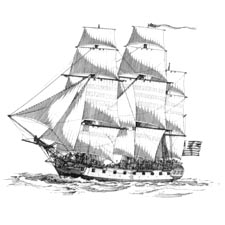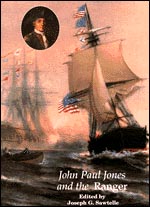|
FRESH STUFF DAILY |
|
|
||
|
|
||
|
|
||
|
SEE ALL SIGNED BOOKS by J. Dennis Robinson click here |
||
With no surviving plans or sketches, the Portsmouth-built warship RANGER, like its captain John Paul Jones, remains intriguingly mysterious. Although often missed in textbooks, the RANGER played a large role in the small Continental Navy. (Bill Gilkerson illustration used with permission)
..proceed with her [Ranger] in the manner you One could say there were really two versions of RANGER, the first designed by John Hackett of Portsmouth, the second reconfigured by John Paul Jones himself after the journey to France. With no written plans ever found, the Ranger is assumed to have inherited much of its design characteristics from the larger RALEIGH and the PORTSMOUTH, both recently completed by Hackett. Off to France and into History Jones and Langdon battled over rigging, artillery, and provisioning as three months dragged on and Captain Jones struggled to find a crew. His handbill advertising the RANGER mission is technically the first recruiting poster in American Naval history. In the end, the Piscataqua sailors of the historic 1777 voyage were not sailors at all, and had their minds set, not on winning glory for America, but on privateering, plunder and a quick trip home. In December, after a speedy voyage to France, Jones and Ben Franklin managed to obtain French funds to replace RANGER's sails and completely refit and rig the ship for the increased speed and maneuverability needed to run a one-ship guerrilla campaign. The RANGER gunports were disguised so ship and crew could be easily mistaken for a British ship. After the pre-arranged salute to the American flag by the French at Quiberon Bay, Jones again returned to port to customize RANGER further. RANGER won its place in history over two short days in 1778 with a near mutinous crew. Though both the American lieutenants aboard refused to participate, Jones managed to get two boatloads of men to row into the British port of Whitehaven and cause a ruckus. Jones himself and his group managed to put two sets of artillery out of commission. Although traitors among his own landing party warned the townspeople, Jones managed to set fire to some small boats before escaping from an onrush of local citizens. Back on RANGER hours later, Jones organized another landing party to attempt the kidnap of the Earl of Selkirk in Scotland. Jones planned to trade the wealthy landowner for American prisoners held in England, but the Earl was out of town. Although he is often depicted wooing the Countess of Selkirk, Jones did not accompany his men when they knocked on the door of the mansion and demanded the family silver. The robbery was a gentlemanly one with the Piscataqua pirates stopping for a glass of wine. Later Jones would buy the Selkirk booty back from his men and return it to Lady Selkirk with a heartfelt apology. French admirers had called the sleek American sloop design a "perfect jewel" and it was now that RANGER showed her worth. In Ireland Jones met HMS DRAKE. Jones captured the advance party sent aboard and instigated a bloody battle that lasted just over an hour. The British surrendered leaving Jones with 200 prisoners that he was later able to trade for American POWs. Here, after another long layover, the RANGER parted company with Jones, returning to the Piscataqua under Captain Simpson. RANGER carried out many more missions. She was later captured by the British and renamed HALIFAX, ironically the city where Portsmouth's final Royal Governor John Wentworth was sent after being driven from New Hampshire in the earliest days of the American Revolution. What Jones had planned, proved true. Though the tiny bites he inflicted were minor, the panicked British reaction was not. There were calls for more fortifications to protect Britain. Insurance rates rose and ships were called home. Continuing his attack with a new ship BONHOMME RICHARD the following year, Jones drew greater attention to the American cause and gained a reputation that remains to this day. By taking the HMS SERAPIS, while his own ship was lost, Jones put the world on notice that America had not yet begun to fight for its freedom and independence. The Aftermath The Ranger remained in service under Capt. Thomas Simpson of Portsmouth and, in the company of other US ships, took a million dollars worth of prizes before being called into service to defend Charleston, South Carolina. The Ranger was captured there in 1780 by the Royal Navy, renamed Halifax and, ironically, decommissioned in Portsmouth, England. The ship was sold as a merchant vessel in 1781 for about 3 percent of her original cost. Legends, more often than facts, make up the history we embrace. According to seacoast oral history, the new flag of the Ranger had to be so hastily created that the women of Portsmouth sacrificed their petticoats to sew it. Though there is no proof of this story, it captures the emotion of the times as effectively as such standards as Longfellowís fictionalized ode to Paul Revere’s ride. The Story of the Ranger inspired a small group of Portsmouth maritime historians to attempt to rebuild Jones’ ship at the close of the 20th century. The plan, though bold, was not to be, and the Ranger Foundation abandoned its efforts in 2003. RANGER FACT SHEET Begun:......January 11, 1777 BUY THE BOOK
Please visit these SeacoastNH.com ad partners.
News about Portsmouth from Fosters.com |
| Friday, April 19, 2024 |


|
Copyright ® 1996-2020 SeacoastNH.com. All rights reserved. Privacy Statement
Site maintained by ad-cetera graphics

 The Shipyard
The Shipyard




 Essays by Julian Fischer in John Paul Jones and the Ranger, edited by Joseph Sawtelle, Portsmouth Marine Society #20, Peter Randall Publisher, 1994, This book contains letters by JPJ and others, plus the first complete printing of the Ranger's logbook, shipís crew list, and a journal by the shipís surgeon.
Essays by Julian Fischer in John Paul Jones and the Ranger, edited by Joseph Sawtelle, Portsmouth Marine Society #20, Peter Randall Publisher, 1994, This book contains letters by JPJ and others, plus the first complete printing of the Ranger's logbook, shipís crew list, and a journal by the shipís surgeon.














